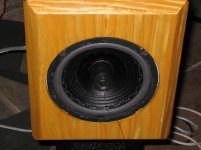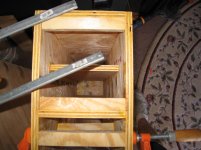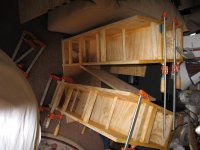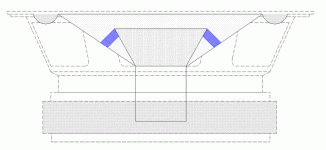Thank you Bud again.
Another question about the Microscale gloss finish treatment: can I substitute it with its flat brother? I am expecting the answer to be a no, but I thought I would ask since that is what I was able to find in a local hobby store.
thank you again
Branko
Another question about the Microscale gloss finish treatment: can I substitute it with its flat brother? I am expecting the answer to be a no, but I thought I would ask since that is what I was able to find in a local hobby store.
thank you again
Branko
Branko,
The flat finish is useful. You can use it to slightly change the phase of an area, so that it is not as productive as the area under gloss. It sounds like you have changed the frequency response, but I could never find any objective evidence to support that. Not that there was much evidence of phase change either, but still, some. It will not provide what the Gloss does, but you will have some of that once Ed gets going. And, you are welcome to what knowledge I have, never think otherwise.
Bud
The flat finish is useful. You can use it to slightly change the phase of an area, so that it is not as productive as the area under gloss. It sounds like you have changed the frequency response, but I could never find any objective evidence to support that. Not that there was much evidence of phase change either, but still, some. It will not provide what the Gloss does, but you will have some of that once Ed gets going. And, you are welcome to what knowledge I have, never think otherwise.
Bud
B20 fun
Dave's drawing This is the TL Nelson Pass designed. It's pretty straightforward, a very conventional TL. Which suits me just fine!
I've been working with the B20. I applied a normal EnABL to most of the cone (un-glossed thus far) including the whizzer, but my block size was too large on the whizzer periphery. This may reduce efficacy somewhat (24-28 pairs or so) but it's likely still a benefit. I'll coat them soon. In the meantime, you can see the progress on nelson's TLs, as well as the coated, enabled (except whizzer) coaxial tweetered (note the tilt- benefits of using electrical tape for a quick mock-up) B20s.
The TLs have some modifications applied. You can see some additional strips of ply inserted for bracing and additional HF diffusion. I'm making them with removable bases so that they can get stuffing modification as needed, so they're adaptable to LE8T, or any other "typical" 8" I want 😎
FUN!
Dave's drawing This is the TL Nelson Pass designed. It's pretty straightforward, a very conventional TL. Which suits me just fine!
I've been working with the B20. I applied a normal EnABL to most of the cone (un-glossed thus far) including the whizzer, but my block size was too large on the whizzer periphery. This may reduce efficacy somewhat (24-28 pairs or so) but it's likely still a benefit. I'll coat them soon. In the meantime, you can see the progress on nelson's TLs, as well as the coated, enabled (except whizzer) coaxial tweetered (note the tilt- benefits of using electrical tape for a quick mock-up) B20s.
The TLs have some modifications applied. You can see some additional strips of ply inserted for bracing and additional HF diffusion. I'm making them with removable bases so that they can get stuffing modification as needed, so they're adaptable to LE8T, or any other "typical" 8" I want 😎
FUN!
Attachments
You may have done yourself a favor with the reduced block set number. In ad hoc experiments, after I gave up trying to find differences in frequency response tests, I found that reducing the number of blocks in the outer ring of any cone will 1a.) roll off the high frequencies, beginning at a lower point as you reduce the number of block sets. 1b.) push the phase of the high frequencies into a greater lag. Take your choice. As you increase the number of block sets, above 36, you do the reverse and the more you add the lower in frequency the effect begins.
So, you have provided a mechanical crossover of sorts. I would avoid putting gloss on the whizzer at least until you have been listening to the finished product for a couple of hundred hours.
Bud
So, you have provided a mechanical crossover of sorts. I would avoid putting gloss on the whizzer at least until you have been listening to the finished product for a couple of hundred hours.
Bud
You may have done yourself a favor with the reduced block set number. In ad hoc experiments, after I gave up trying to find differences in frequency response tests, I found that reducing the number of blocks in the outer ring of any cone will 1a.) roll off the high frequencies, beginning at a lower point as you reduce the number of block sets. 1b.) push the phase of the high frequencies into a greater lag. Take your choice. As you increase the number of block sets, above 36, you do the reverse and the more you add the lower in frequency the effect begins.
So, you have provided a mechanical crossover of sorts. I would avoid putting gloss on the whizzer at least until you have been listening to the finished product for a couple of hundred hours.
Bud
That was pretty much the idea (It's okay, not the complicated "phase etc" version). I'm still deciding how to apply the gloss coat under the whizzer. Since I'm using the coax supertweeters, loss of highs is AOK by me. The other usage application for these is as extended mids, so the whizzers may get cut off entirely at a later date.
For now, these pioneers are really great drivers, with a lot of capability as music makers, hence going through the trouble of doing a 'better' cab for them. The little cabs are very nice and work real trick, but I think the TL should do better still.
Hey Badman,
how do they sound with the tweeter in? I have put my "tweeterplugs" in a few days ago and put the drivers back into the voight pipes while i am waiting for my EnABLe kit (and while I practice on other drivers). My impressions: Hello cymbals! the speakers definitely opened up a lot, but the addition of a tweeter did not solve all the problems of the driver. In fact it crated new ones. The tweeter seems to be producing frequencies that hurt my ears. Hi frequencies. Also the balance in volume between the tweeter and the rest of the driver is not there. Tweeter seems to be louder (I wander if this is caused by the the phase plugs being too long and the tweeter thus extending about a 1/8" over the edge f the whizzer. The strange mid frequencies (around the human voice range) that the driver used to produce before the modification are still there but they seem brighter - as if the singer was singing through rolled up sheet of paper - (like a toy loudspeaker). Maybe it is caused by the removed dust cap, maybe the phase plug is too small in diameter? The bass is more tight, thanks to the modgpodge treatment I think. I think that over all they do sound better thanks to the tweeter (my wife definitely thinks so) but it is not easy listening anymore. It takes effort now.
Let me know what you think
Branko
how do they sound with the tweeter in? I have put my "tweeterplugs" in a few days ago and put the drivers back into the voight pipes while i am waiting for my EnABLe kit (and while I practice on other drivers). My impressions: Hello cymbals! the speakers definitely opened up a lot, but the addition of a tweeter did not solve all the problems of the driver. In fact it crated new ones. The tweeter seems to be producing frequencies that hurt my ears. Hi frequencies. Also the balance in volume between the tweeter and the rest of the driver is not there. Tweeter seems to be louder (I wander if this is caused by the the phase plugs being too long and the tweeter thus extending about a 1/8" over the edge f the whizzer. The strange mid frequencies (around the human voice range) that the driver used to produce before the modification are still there but they seem brighter - as if the singer was singing through rolled up sheet of paper - (like a toy loudspeaker). Maybe it is caused by the removed dust cap, maybe the phase plug is too small in diameter? The bass is more tight, thanks to the modgpodge treatment I think. I think that over all they do sound better thanks to the tweeter (my wife definitely thinks so) but it is not easy listening anymore. It takes effort now.
Let me know what you think
Branko
Branko- what tweeter did you use? What capacitor value?
I did find that the B20s benefitted from the 99c tweak- foam between whizzer and main cone. I haven't found an implementation I'm happy with on it yet. Experimenting with ladies stockings filled with batting, but seems like too much added mass.
I did find that the B20s benefitted from the 99c tweak- foam between whizzer and main cone. I haven't found an implementation I'm happy with on it yet. Experimenting with ladies stockings filled with batting, but seems like too much added mass.
badman,
I used Dayton ND16FA-6 5/8" Neodymium Dome Tweeter and Dayton DMPC-2.0 2.0uF 250V Polypropylene Capacitor (one on each speaker). Pretty much what gychang used. I will see what EnABLe will do for the driver and I am also hoping that the driver and the tweeter will sound better after "break-in period".
Branko
I used Dayton ND16FA-6 5/8" Neodymium Dome Tweeter and Dayton DMPC-2.0 2.0uF 250V Polypropylene Capacitor (one on each speaker). Pretty much what gychang used. I will see what EnABLe will do for the driver and I am also hoping that the driver and the tweeter will sound better after "break-in period".
Branko
First thing- try the 99c tweak (foam or other acoustic absorbtion between whizzer and main cone (or, pain cone and main cone, if you prefer)),
Then try a smaller cap.... then a .5mH coil (aircore) in parallel with the tweeter (after the cap)
Then try a smaller cap.... then a .5mH coil (aircore) in parallel with the tweeter (after the cap)
badman, I am a complete novice at this stuff so i really do not know what you are talking about. Any more detail on the 99c tweak? Maybe a picture?Also what is a .5mH coil? maybe a little schematics would help.
thank you very much
Branko
thank you very much
Branko
First thing- try the 99c tweak
I believe the "official" name is 98 cent tweak 🙂
dave
Attachments
Hi Branko:
The 99c tweak is simple, you just get some sort of acoustically absorbent material, like batting or cottonballs or lightweight open-cell foam, and put it between the whizzer and the main cone. You have to experiment to find what works for you. The pioneers can move real air, unlike most fostex or lowther speakers, so you may have to find a solution that doesn't shake loose. My batting did when playing some bass-heavy content.
An inductor is an inductor... a coil of wire..... _mm_ on a schematic. .5mH is the value.... any electronics shop of decent size, or audio parts vendor will have them. Avoid steel cores, you don't need to worry about wire size either. Thin wire (20 awg) is fine for this location.
The 99c tweak is simple, you just get some sort of acoustically absorbent material, like batting or cottonballs or lightweight open-cell foam, and put it between the whizzer and the main cone. You have to experiment to find what works for you. The pioneers can move real air, unlike most fostex or lowther speakers, so you may have to find a solution that doesn't shake loose. My batting did when playing some bass-heavy content.
An inductor is an inductor... a coil of wire..... _mm_ on a schematic. .5mH is the value.... any electronics shop of decent size, or audio parts vendor will have them. Avoid steel cores, you don't need to worry about wire size either. Thin wire (20 awg) is fine for this location.
I believe the "official" name is 98 cent tweak 🙂
dave
Sir, your economics skills are severely lacking.
What about inflation?!
>>> I haven't found an implementation I'm happy with on it yet.
Badman, i agree so i have accepted the B20 for what it is stock and enjoy it everyday but... your comment above makes me wonder if there is not even more 'real' potential for this driver. The driver is great but for a midrange veil or grunge that's not as open and clean as Fostex or TB IMHO. I love how this 'wide range' driver does bass and we can easily fix the top octave with various tweeters... but how to make the upper mids better is what i think needs to be figured out to make this driver more than just an entry level introduction into full range drivers. Could it be a phase plug? Strategic cuts in the cone... enable... a modified wizzer? This driver is so easy to work with and so close to being 'great' maybe we can as a group think of ways to further improve it's performance in the critical upper mids? To me, the wizzer looks very wide. Could it's design be improved? Was it added originally simply to extend FR rather than optimize performance?
Godzilla
Badman, i agree so i have accepted the B20 for what it is stock and enjoy it everyday but... your comment above makes me wonder if there is not even more 'real' potential for this driver. The driver is great but for a midrange veil or grunge that's not as open and clean as Fostex or TB IMHO. I love how this 'wide range' driver does bass and we can easily fix the top octave with various tweeters... but how to make the upper mids better is what i think needs to be figured out to make this driver more than just an entry level introduction into full range drivers. Could it be a phase plug? Strategic cuts in the cone... enable... a modified wizzer? This driver is so easy to work with and so close to being 'great' maybe we can as a group think of ways to further improve it's performance in the critical upper mids? To me, the wizzer looks very wide. Could it's design be improved? Was it added originally simply to extend FR rather than optimize performance?
Godzilla
>>> I haven't found an implementation I'm happy with on it yet.
Badman, i agree so i have accepted the B20 for what it is stock and enjoy it everyday but... your comment above makes me wonder if there is not even more 'real' potential for this driver. The driver is great but for a midrange veil or grunge that's not as open and clean as Fostex or TB IMHO. I love how this 'wide range' driver does bass and we can easily fix the top octave with various tweeters... but how to make the upper mids better is what i think needs to be figured out to make this driver more than just an entry level introduction into full range drivers. Could it be a phase plug? Strategic cuts in the cone... enable... a modified wizzer? This driver is so easy to work with and so close to being 'great' maybe we can as a group think of ways to further improve it's performance in the critical upper mids? To me, the wizzer looks very wide. Could it's design be improved? Was it added originally simply to extend FR rather than optimize performance?
Godzilla
Added simply to extend FR..... that's the only reason a whizzer's ever used. It never improves frequency response linearity in the "below whizzer" band, nor lowers distortion. Trimming it back might make it less significant acoustically but might also require more supertweeter contribution. No free lunch!
Have you done the 'standard' planet 10 mods (modge podge, enabl, frame damping, phase plug)? I've done all these, but the first obvious change that made a huge difference was the dustcap removal. This is a major limiting factor in the B20. It does require a phase plug or a coaxial supertweeter mounting. The frame is also pretty substantial and does benefit from some backwave treatment. I wrapped them in bamboo fiber batting and ziptied it in place, to good effect.
These two things reduced some of the 1kHz impedance ripple and cleaned up the midrange quite a bit. The modge podge and enabl go quite a bit further to 'refining' the performance.
I'm a picky guy, but the B20 is a superb 'starting point' driver. First do no harm.... even stock, the B20 meets this criterion. Once fully tricked out, it's much better. It's not a low distortion motor by any stretch, but that doesn't matter as much during normal output levels, and even less so in a serious enclosure (TL/BIB/BLH/BVR) with wideband excursion control.
It'll never be transparent like ff85ks (especially with appropriate tricks applied), but very few things are.
Start cutting godzilla! Yer a monster fer gosh sake!
Last edited:
Should i just eliminate the whizzer altogether? I have the tweeter now to extend the FR so what is the point of keeping it?
Has anyone done this?
Branko
Has anyone done this?
Branko
Sir, your economics skills are severely lacking.
What about inflation?!
No inflation... just want people to be able to find it with a search
original link long gone
http://gainclone.com/FullRangeArchive/fr2/13109.htm
a couple other refs...
http://gainclone.com/FullRangeArchive/fr1/3471.htm
http://fullrangedriver.com/forum/viewtopic.php?id=295
dave
Here's what's left of the original webpage: http://web.archive.org/web/20020628234451/http://www.mindspring.com/~darmah/lowther/mods.htm
GM
GM
Branko,
Applying a pattern ring in the mid cone area, location confirmed by a tap test, and then applying another ring at the first null zone found toward the surround, will probably provide enough phase and frequency lift to allow a reasonable cross over, without a whizzer in place. That first ring is the location where the decay of a tap changes from first retuning to the voice coil to no direction to decaying toward the surround. I provided loninappleton a detailed description here,
http://www.diyaudio.com/forums/showpost.php?p=1904510&postcount=186
The whizzers appear to be sized and placed to take advantage of this arc back, out in the air. That a thin layer of foam aids the clarity of this combination, when placed as a wall between cone and whizzer does seem to support this. And, I have yet to find a major resonance node on a full range cone with whizzer, that did not have the whizzer outer edge at this location.
My suggestion is to pattern the main cone and get rid of the whizzer altogether. I have not ever treated one of these drivers however. I believe Dave has done a few and he may have a suggestion or two. You certainly will have to treat the tweeter in either case.
Bud
Applying a pattern ring in the mid cone area, location confirmed by a tap test, and then applying another ring at the first null zone found toward the surround, will probably provide enough phase and frequency lift to allow a reasonable cross over, without a whizzer in place. That first ring is the location where the decay of a tap changes from first retuning to the voice coil to no direction to decaying toward the surround. I provided loninappleton a detailed description here,
http://www.diyaudio.com/forums/showpost.php?p=1904510&postcount=186
The whizzers appear to be sized and placed to take advantage of this arc back, out in the air. That a thin layer of foam aids the clarity of this combination, when placed as a wall between cone and whizzer does seem to support this. And, I have yet to find a major resonance node on a full range cone with whizzer, that did not have the whizzer outer edge at this location.
My suggestion is to pattern the main cone and get rid of the whizzer altogether. I have not ever treated one of these drivers however. I believe Dave has done a few and he may have a suggestion or two. You certainly will have to treat the tweeter in either case.
Bud
- Status
- Not open for further replies.
- Home
- Loudspeakers
- Full Range
- Pioneer 8" B20



